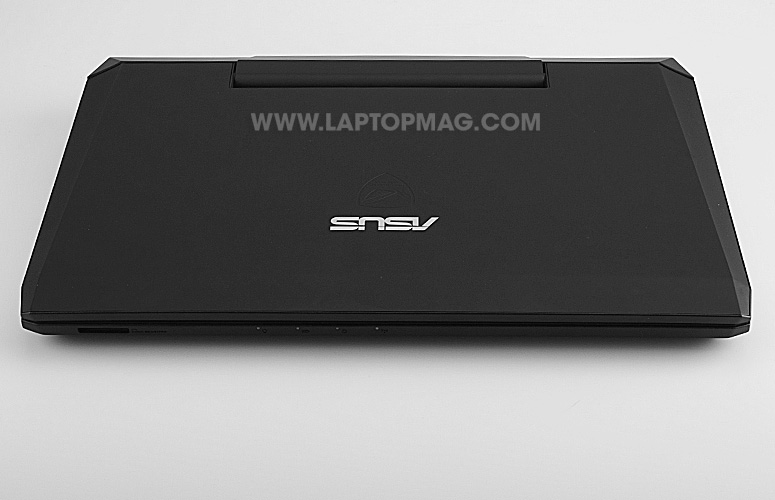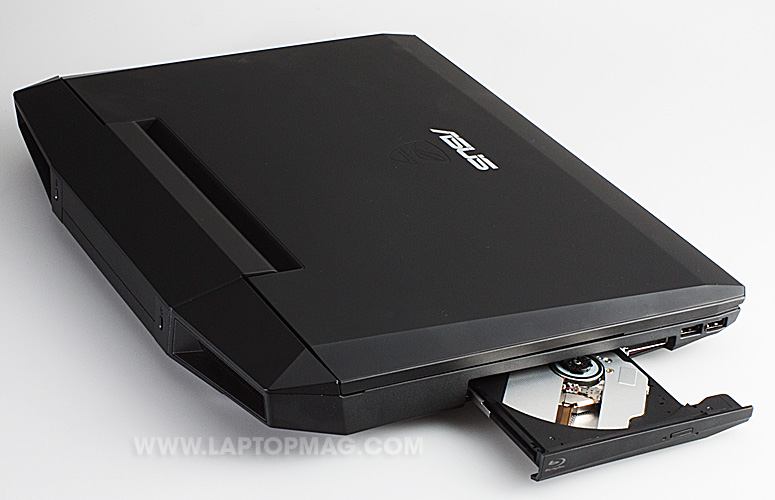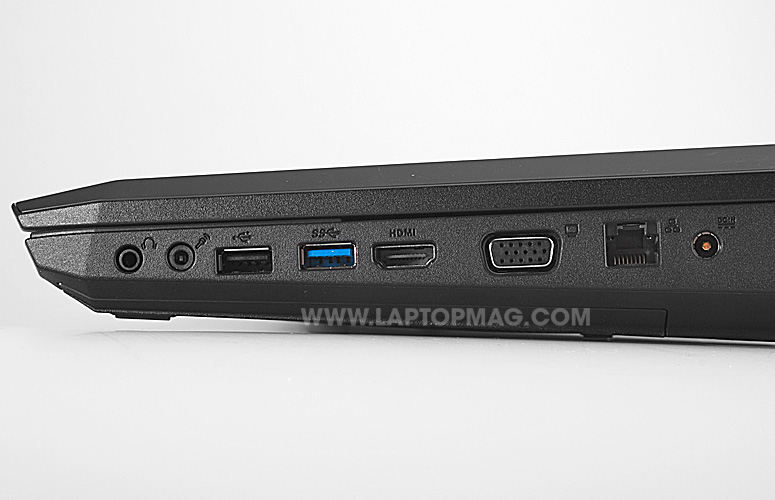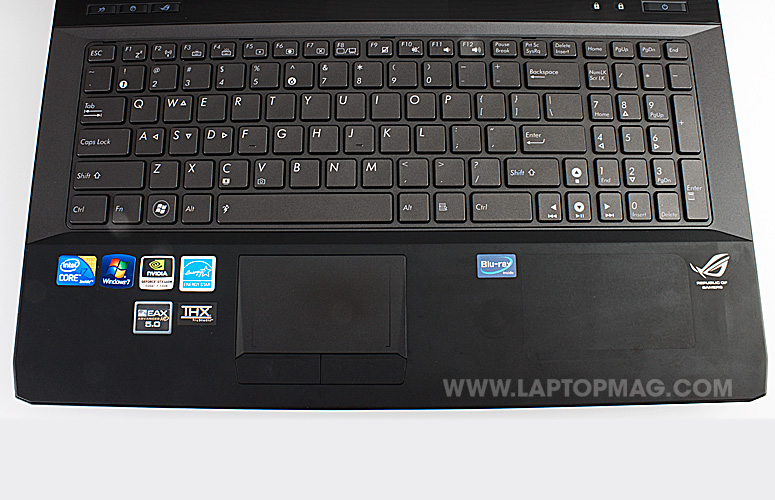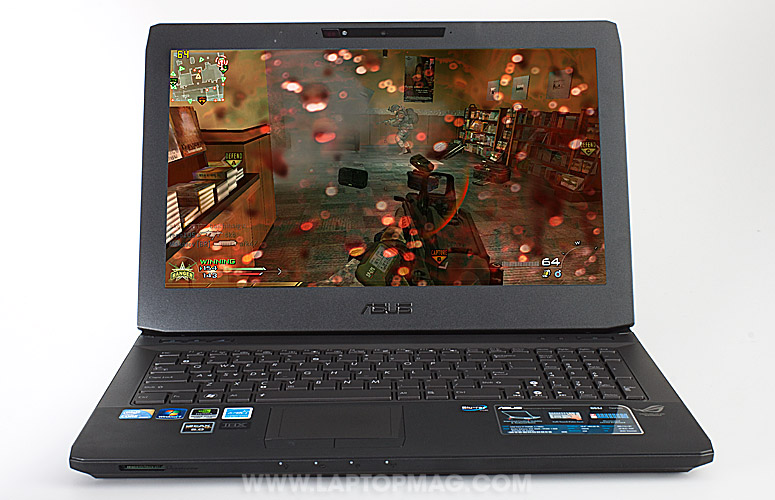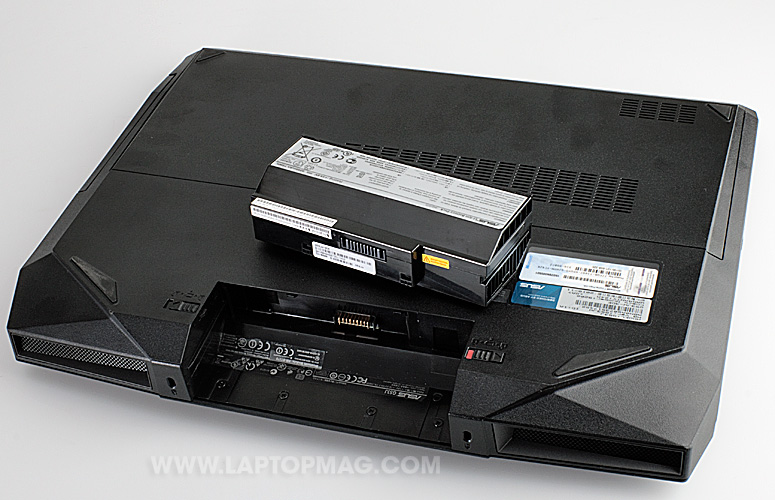Laptop Mag Verdict
A 3D notebook that justifies its high price with intense gaming action and plenty of style.
Pros
- +
Stylish stealth fighter-like design
- +
Impressive graphics and 3D performance
- +
Cool temperatures
- +
Blu-ray and USB 3.0
Cons
- -
Relatively heavy
- -
Stiff mouse buttons
- -
Display not 1080p
- -
Lackluster audio
Why you can trust Laptop Mag
Want the power of a 17-inch gaming system in a slightly smaller package? Asus took the components from the G73Jh--a Core i7 processor, Nvidia GTX 460 graphics, Blu-ray, and a USB 3.0 port, to name a few--and squeezed them into the 15-inch G53Jw-3DE. While it may be smaller, this $1,769 system still looks like a stealth fighter, and has the muscle to fly through the latest titles. Not only that, but the company also embedded Nvidia's 3D display technology so gamers can now add a third dimension to their fragging. Is the G53Jw-3DE the ultimate portable gaming notebook? Read on to find out.
Design
The G53Jw-3DE is the smaller cousin to the G73; as such, it has the same stealth fighter-inspired design, only in a (relatively) less bulky package. At 15.6 x 11.9 x 0.8-2.1 inches, the G53Jw is about an inch smaller than the G73, though both are roughly the same thickness--2.1 inches. At 7.9 pounds, it's also about a pound lighter than the G73, but a pound and a half heavier than the Acer Aspire 5745DG. The G53Jw is even about half a pound heavier than the HP Envy 17.
Modeled after the F-117 Nighthawk stealth fighter, the G53Jw lacks the bling of colorful notebooks like the Alienware M17x, but its sleek, angular design and gunmetal gray exterior make it one of the most attractive systems we've seen. The dual exhausts on the back combine with the subtle silver ASUS logo and Republic of Gaming emblem to make this product look more like one of the planes you'd fly in a game than the notebook you'd be gaming on. Open up the lid, and the subtle theme continues inside. Only a few small buttons sit on top of the simple black keyboard and the gray touchpad simply blends into the deck. No colorful status lights or bright red buttons here.
Click to enlarge
What really makes the G53Jw stand out is the rubberized material used on both the lid and deck. More notebooks should use this type of material, because it's incredibly comfortable to touch, resists finger prints, stays cool, and provides a significant feeling of durability and quality.
Ports and Webcam
Sign up to receive The Snapshot, a free special dispatch from Laptop Mag, in your inbox.
The G53 has a decent amount of ports in its large frame. On the right side are Ethernet, HDMI-out, VGA-out, and two USB ports, one of which is USB 3.0. On the left side is a Blu-ray drive and two more USB ports. The left front lip has an 8-in-1 card slot, and the back has not one but two Kensington lock slots.
Click to enlarge
The 2-megapixel webcam delivered sharp, colorful images even in the low light. In our dimly lit cubicle, our Skype image was smooth, sharp, and noise-free.
Click to enlarge
Keyboard and Touchpad
The G53Jw's backlit keyboard features chiclet-style keys that were fairly comfortable to type on. However, their flat, square shape lacks the kind of curves that make it easy to feel your way around the rows, and the narrow space between them seems smaller than other devices.
Click to enlarge
Unfortunately, the arrow keys and numeric keypad--both essential for gameplay--are smaller than the rest of the keys, making it difficult to use them as controls. We also would have preferred dedicated media controls, or failing that, reversed Function keys.
Size-wise, the 4.4 x 2.2-inch touchpad has everything going for it: a large, smooth--but not too smooth--surface, multitouch gesture support, and two discrete buttons that offer just the right amount of tactile feedback. However, the buttons were a bit stiff.
Heat
For a notebook with a Core i7 CPU and power Nvidia graphics card under the hood, the G53Jw stays extremely cool. After streaming a video at full screen for 15 minutes, we measured the keyboard at a cool 88 degrees, the bottom at a temperate 92 degrees, and the touchpad at a chilly 82 degrees. Unlike other gaming notebooks that have hot palm rests and decks, we didn't notice a single hot spot on the G53Jw even when we were gaming--and that's quite an impressive feat. We consider temperatures below 95 degrees comfortable and below 90 degrees to be basically imperceptible.
Display and Sound
As with most 15.6-inch displays, the one on the G53Jw has a resolution of 1366 x 768. While this is fine for mainstream audiences, we would have hoped for a few more pixels, especially in a 3D gaming machine, and especially one that has a Blu-ray player. Still, the glossy screen provided sharp, clear images that didn't wash out even at 90 degree viewing angles to the left or right. However, it's not the brightest panel we've seen; even at 100 percent brightness, images didn't pop like they did on the HP Envy 17.
Click to enlarge
The speakers on the G53Jw provided audio that was loud enough to fill a living room, and good enough for watching films and playing games. While there was good sound separation and higher tones were well-defined, we were disappointed in the lack of bass when listening to the Fugees "No Woman No Cry" and Lady Gaga's "Poker Face." Adjusting the audio settings using the included THX app had little to no effect.
3D Experience
Like the Acer Aspire 5745DG, the Asus G53Jw uses Nvidia's active-shutter technology to generate and display 3D content. A transmitter inside the notebook communicates with a pair of included glasses, whose lenses flicker on and off to create a 3D effect.
Click to enlarge
The glasses, which must be recharged via miniUSB, weigh just 1.8 ounces and are comfortable to wear, even for those who also wear glasses. We like that the Nvidia specs have a green light indicating they're working. The Xpand glasses that came with the HP Envy 17 3D (which uses ATI's 3D technology) can't be recharged; you have to replace a small watch-sized battery--and there's no light telling you they're on.
As with the Acer 3D notebook, both the screen and the glasses flickered for a second or two when preparing to show 3D content; it was a bit more distracting than the AMD/ATI technology used in the HP Envy 17. Plus, Nvidia's 3D glasses make things seem darker than when using ATI's glasses.
3D Gaming
Nvidia's 3D Vision technology currently supports roughly 450 games, including such popular titles as Call of Duty: Black Ops and World of Warcraft. First-person shooters take some adjustment, as looking through a rifle scope in 3D is a bit disorienting; fortunately, Nvidia adds a laser sight to help you aim--you can even select what the sight looks like in Nvidia's control panel. Regardless, we found it easier to close one eye when aiming, just like in real life.
3D Content and Movies
Apart from games, there's not much in the way of 3D content out there. Amazon only lists about 25 3D Blu-rays; one of them, the IMAX Space Station 3D documentary, looked good on the G53J, but wasn't as impressive as on the Envy 17's full HD panel.
Like the TriDef software on the Envy 17, the included Roxio CinePlayer on the G53J also does its best to convert 2D DVDs (though not Blu-rays) to 3D; while not as good as movies filmed in 3D, this player did a fairly good job with Jet Li's Fearless, among other flicks. The software also lets you adjust the 3D-ness of movies on the fly.
While the world waits for the 3D Avatar Blu-ray to appear, Nvidia is also trying to generate more 3D content through its beta site, 3dvisionlive.com, which has a number of 3D videos. While content is limited, Nvidia says the site will soon allow users to post their own 3D photos and videos. The company also told us that a driver update in the next few weeks would add support for Google Earth; something you can already view using TriDef's software on the Envy 17 3D.
One other nice feature of Nvidia's GPU is that users can output 3D content to a 3D-capable display or projector via the notebook's HDMI 1.4 port. This somewhat makes up for the lack of an HD panel on the G53J itself.
Performance
With its 1.73-GHz Core Quad Core i7 Q740 CPU, Nvidia GTX 460 graphics chip, and a 7,200-rpm hard drive, the ASUS G53Jw-3DE offers performance that's good enough for hardcore gaming, video editing, and simple productivity apps. On PCMark Vantage, a benchmark that measures overall system performance, the laptop scored 4,913, which is about 200 points above the mainstream average but well below the desktop replacement average (5,598) as well as the Acer Aspire 5745DG (5,776), the Dell XPS 15 (6,112), and the HP Envy 17 3D (5,888).
Out of the box, the G53Jw booted into Windows 7 Home Premium in a slow 75 seconds, 10 seconds slower than the category average. Where the G73 had dual 7,200-rpm hard drives, the G53J has a single, 750GB, 7,200-rpm drive. It completed our File Transfer Test in 3 minutes and 34 seconds for a rate of 23.8 MBps, about 10 MBps slower than the G73Jw and the desktop replacement category, but about even with the mainstream average of 24.3 MBps.
Still, when it came to transcoding video, the G53Jw took just 58 seconds to convert a 114MB MP4 file to AVI format. That's 9 seconds faster than the desktop replacement average and two seconds faster than the Envy 17, but 5 seconds slower than the Aspire 5745DG.
Graphics
Thanks to its GTX 460 discrete graphics chip, the G53Jw has fairly strong graphics capabilities. On 3DMark06, a benchmark that measures overall graphics prowess, the notebook scored 8,640. That figure is more than 1,000 points above the desktop replacement average, and more than double the Aspire 5745DG (4,092), but is still dwarfed by the Envy 17 (10,482), not to mention the G73Jh (12,397).
The G53Jw is more than a decent gaming rig, notching 97 frames per second in World of Warcraft and 41 fps in Far Cry 2 with the screen at its native resolution and settings maxed. While much better than the Aspire 5745DG, which topped out at 18 fps on Far Cry 2, the G53Jw's results are nearly the same as the HP Envy 17 (41 fps), and that system has a 1080p display to power.
Battery Life and Wireless
We don't expect good endurance on gaming systems, so we weren't surprised when the G53Jw lasted just 1 hour and 59 minutes on our LAPTOP Battery Test (web surfing via Wi-Fi). That's about 50 minutes less than the desktop replacement average, but on par with the G73Jw and 45 minutes longer than the HP Envy 17. Considering that playing games sucks up juice much faster than surfing the web, it's safe to say that you'll want to stay near an outlet.
Even if you have to keep the G53Jw plugged in all the time, you don't need to keep it near the router. The 802.11n Atheros AR9285 wireless card managed strong transfer rates of 46.7 Mbps and 29.4 Mbps at distances of 15 and 50 feet from our router, respectively.
Configurations
Our review unit of the G53Jw carries an MSRP of $1,769. However, the system has a starting price of $1,399 and various configurations will be available with different amounts of RAM and hard drive capacity, and with or without Blu-ray. However, all versions will carry the same processor and graphics card.
Click to enlarge
ExpressGate Instant On OS
If you don't want to wait over a minute to boot into Windows 7, hit the ExpressGate instant boot button that sits in the upper left portion of the deck. That loads ASUS's ExpressGate Cloud instant-on OS in a mere 19 seconds. ExpressGate Cloud is a version of the popular Splashtop instant-on OS that we've seen on dozens of computers from ASUS, HP, Lenovo, and others. With this version, you can browse the web, view photos in a photo gallery, or play a few simple games such as BlackJack or Klondike.
Software and Warranty
ASUS includes a suite of utilities with the G53Jw. ASUS Splendid allows you to switch between different video modes for improved movie playback or gaming. SmartLogon Manager sets up facial recognition logins. Security Manager allows you to lock files away in password protected, encrypted vaults. LifeFrame allows you to take photos and videos with the webcam. Fast Boot allows you to delay the loading of certain tray apps to speed up start times. Control Deck gives you a neat 3D interface to help you switch between these. Power4Gear is a power manager.
Click to enlarge
ASUS bundles the G53Jw with a two-year warranty, 24/7 toll-free tech support, and a year of accidental damage protection. To see how ASUS fared on our latest tech support showdown, click here.
Verdict
On its own, the Asus G53Jw-3DE is a powerful 3D gaming notebook: You get a Core i7 processor, Nvidia graphics, 3D display, and Blu-ray for $1,769. Another good choice in this category is the HP Envy 17 3D, which not only has a larger, brighter, and higher-resolution screen, but performs just as well, weighs less, and costs nearly $100 less. Still, Nvidia's 3D Vision supports more games than ATI's technology, which powers the Envy, and you don't have to use special software to start playing. While some may want to wait for Asus to bring 3D to its 17-inch G73J, which has a 1080p display, the 15.6-inch G53Jw-3DE is a solid 3D notebook.
ASUS G53Jw-3DE Specs
| Bluetooth | Bluetooth 2.1+EDR |
| Brand | ASUS |
| CPU | 1.73-GHz Intel Core i7-740QM |
| Card Slots | 8-1 card reader |
| Company Website | www.asus.com |
| Display Size | 15.6 |
| Graphics Card | Nvidia GTX 460M |
| Hard Drive Size | 750GB |
| Hard Drive Speed | 7,200rpm |
| Hard Drive Type | SATA Hard Drive |
| Native Resolution | 1366x768 |
| Operating System | MS Windows 7 Home Premium (64-bit) |
| Optical Drive | BD-ROM/DVDRW DL |
| Optical Drive Speed | 8X |
| Ports (excluding USB) | Headphone, HDMI, Ethernet, eSATA/USB, USB 3.0, Kensington Lock |
| RAM | 6GB |
| RAM Upgradable to | 8GB |
| Size | 15.6 x 11.9x 0.8-2.1 inches |
| Touchpad Size | 3.25 x 1.9 |
| USB Ports | 3 |
| Video Memory | 1.5GB |
| Warranty/Support | 2-year Parts and Labor, 1 year Accidental Damage, 30-day Zero Bright Dot Guarantee, 2-way free shipping, 24/7 Tech Support |
| Weight | 7.9 pounds |
| Wi-Fi | 802.11b/g/n |
Michael was the Reviews Editor at Laptop Mag. During his tenure at Laptop Mag, Michael reviewed some of the best laptops at the time, including notebooks from brands like Acer, Apple, Dell, Lenovo, and Asus. He wrote in-depth, hands-on guides about laptops that defined the world of tech, but he also stepped outside of the laptop world to talk about phones and wearables. He is now the U.S. Editor-in-Chief at our sister site Tom's Guide, where he oversees all evergreen content and the Homes, Smart Home, and Fitness/Wearables categories for the site..
